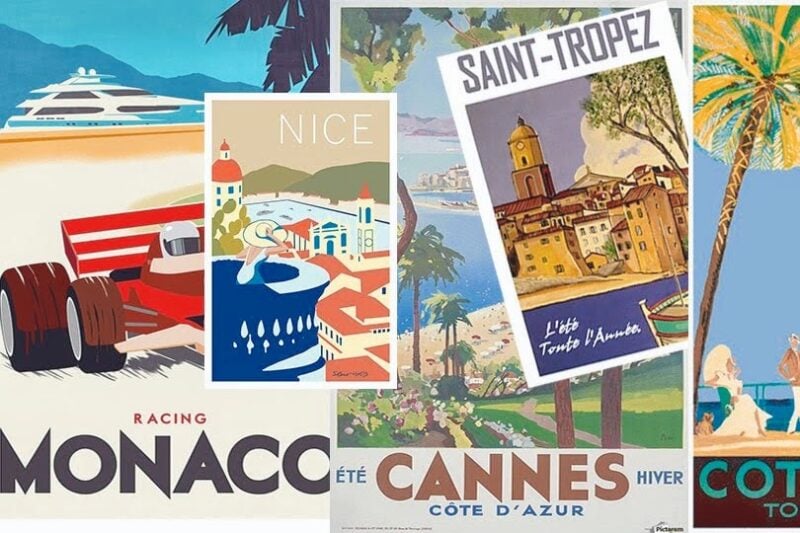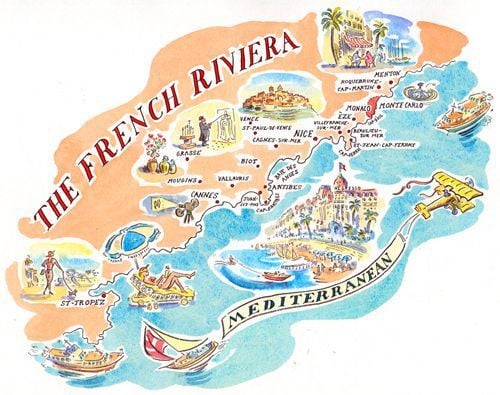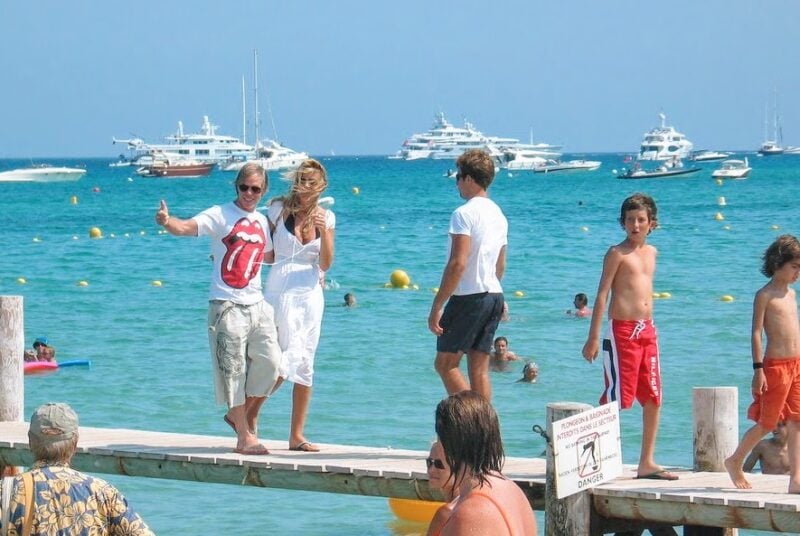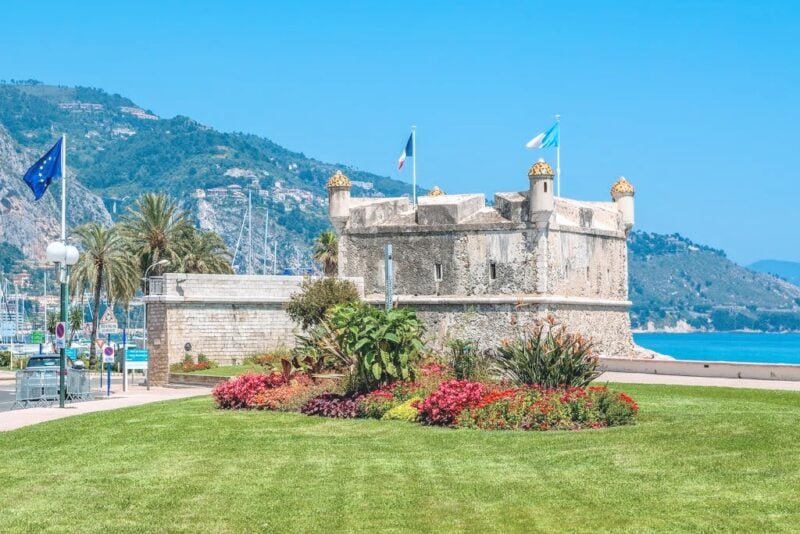Shortcuts
Why the French Riviera?
Welcome! You’re viewing the #1 most popular travel guide to the French Riviera. Part of the reason that Iconic Riviera is so popular is because it’s written by locals and we tell it like it is.
In the navigation menu above you’ll see a list of towns (and if the list seems overwhelming, don’t worry — there’s a summary of each town below). Each contains travel guides and event listings, as well as recommendations for where to go for fun, to see nature, to a spa, shop and sleep, and more. We also have an events calendar that you can subscribe to via Google Calendar.

Whether you are looking for a day that starts (and ends) with rosé at a celeb-filled beach club or prefer a more secluded seaside or historic village escape, Iconic Riviera will fill you in on the very best places to find whatever you’re looking for. Read on to find out why the French Riviera towns attract so many artists, celebrities, sun-seekers, and jet-setters.
To start you off on your French Riviera journey here is the perfect overview of the area:
Why People Love the French Riviera
The French Riviera is a blissful place where palm trees sway in the warm breeze and the sea is more blue than you’ve ever seen; where you can still spot the influence of European royalty from long ago; and where A-listers have called ‘home’ for years. Set in the south-east of France, the French Riviera stretches from Menton to Nice, Antibes, Cannes, St. Tropez and –depending on who you ask– Cassis.
While the French Riviera has maintained a glam reputation since the ’50s (Brigitte Bardot basking on St. Tropez’s beaches; A-listers strutting down Cannes’ red carpet), there is more to the Côte d’Azur than just its jet-set resort towns—including idyllic bohemian islands, hilltop medieval towns housing their own Michelin-starred restaurants, and a world-class arts scene.

The French Riviera is dotted with hidden gems steeped in local history, excellent cuisine, and artist’s hideaways. Head inland from the waterfront bustle to explore towns immersed in rich Mediterranean culture, where pristine vineyards hug hillside contours and an array of artisan activity provides endless appeal.
Dramatic, diverse, and picturesque, this area is home to numerous ‘villages perchés’; ancient hillside towns packed with thriving communities, where secluded luxury blends with history. Such unique enclaves of inspiration indeed project an inimitable pull, ready to enchant and beguile the senses of those who come to explore.
It is no secret that the evocative Cote d’Azur has long been a big draw for artists, resulting in masterpieces that have changed the face of art as we know it. These favored haunts have aroused such passionate vision thanks to the peerless blue waters and vivid sunsets, a fact easy to appreciate when watching the exquisite light flicker across the undulating coastline.

The French Riviera is known for its beaches, views, picture-perfect water, yachts, and as a playground for the wealthy. It is the place for the world’s elite to rub shoulders every summer. The ports glitter with superyachts. Craggy cliffs jut over a turquoise sea, forming the French Riviera’s famously rocky coastline. Quaint villages and coves are hidden between the region’s cities and towns, the most famous of which are Monaco, Saint-Tropez, Nice, and Cannes.
The area benefits from up to 330 days of annual sunshine, 115 kilometers of coastline, 18 golf courses, 14 ski resorts, and 3000 restaurants. So, wherever you visit the Riviera, you can be sure that there’ll be plenty to do!

The nickname Côte d’Azur (or the Blue Coast) comes from the turquoise Mediterranean Sea. The word Riviera means coast in Italian. This area of the French Mediterranean coast is one of the world epicenters of tourism. Luxury, tradition, culture, leisure, beach and mountains meet on the Côte d’Azur to make it a memorably special place.
Where is the French Riviera?
The French Riviera, which is also sometimes referred to as the Côte d’Azur, is arguably the most exciting place in the world. The French Riviera is the beautiful coastline in the south-east of France along the Mediterranean Sea. It covers about 550 miles and acquired the nickname Cote d’Azur or Azure (Blue) coast in 1887.
The French Riviera is set between the Southern Alps mountain region and the Mediterranean. It is the beating heart of Mediterranean Europe. The Alpes-Maritimes département encloses it. There is no official boundary but most locals consider somewhere near Saint Tropez to be the soft border on the west side, and the France-Italy border is on the east, twenty minutes past Menton. Nice, a piece of jewel on the south-east coast of France, serves as the unofficial capital as it is the largest city of the region.

The French Riviera is at the heart of Europe, between the Southern Alps and the Mediterranean, from Cassis to Menton. The Mercantour National Park, together with the 13 other natural parks in the Côte d’Azur department, make up a vast playground for hiking, horseback riding, mountain biking, canyoning, climbing, and caving. This region also houses 15 ski resorts with over 700 kilometers of slopes.
A Visual Overview
This video gives a great overview of the area:
The Riviera Climate
The French Riviera
It’s warmer by the water, and cooler as you move away from the coast. The surest thing is the presence of sunshine all year round, with 330 days of summer every year. With its Mediterranean climate and the Alps’ shelter from harsh winds, you can be sure to be comfortable at any time of year.
Check out our guide to the climate, weather and when to visit the French Riviera.


The People of the French Riviera
Let’s be real. For some time France has been a country that does not like itself. Somewhere on the road from its humiliation in World War II to its disappointment with European integration to its discomfort with globalization, France slid into moroseness. High-speed trains purred; France pouted. Teachers refuse to give A+ grades for A+ work while students grew up thinking they were never good enough. NON! became the mot-du-century, and grumbling became a way of life; the response to lost grandeur.
One of the few exceptions to this is the French Riviera. Perhaps it’s the sun and beaches, the huge tourism business, or the fact that it’s generally a wealthy area, but people in the south of France are quicker to smile than their northern countrymen.

The French Riviera has a total population of over two million. As you may have guessed, most of the population is French, and the official language is French, but most people speak English since there are plenty of Brits and Italians who have second homes or who have moved to the area. It’s easy to get along in English and many signs are in both languages in the most touristy areas.
Modern middle-eastern monarchs and nouveau-riche also want the taste of luster and wealth the French Riviera gives. In the past decade the French Riviera has seen a growing number of Russian, Middle-Eastern, and Chinese tourists, many who are scooping up luxurious waterfront villas and shipping in their custom Lamborghini for the season.
How the French Riviera Got So Popular

So, as you may have noticed by now, the French Riviera seems to be an area of great wealth. But has it always been like this? Well as a matter of fact, yes it has.
Originally, the Riviera served as a winter resort for the British aristocracy who wished to escape Britain’s miserable weather. Coincidentally, around the same time, the idea of climatotherapy (a change in climate) was being advertised as a cure to major diseases such as tuberculosis. With the combination of the two factors, the Riviera became littered with British nobility.
Further down the line, the establishment of a railway provided access to the Riviera from the rest of Europe. Soon after its completion, Tsar Alexander II of Russia, Napoleon III, and Leopold II visited the Côte d’Azur. It wasn’t long before Queen Victoria and Prince Edward VII also visited the coastline, and the two soon became frequent visitors.

What followed was a parade of famous artists, movie stars and film sets that cemented the French Riviera at the top of the list for luxury travel. The coast also attracted its fair share of world-renowned painters. Henri Matisse and Pablo Picasso, for example, frequented the Nice and Antibes area. While Auguste Renoir settled in Cagnes-sur-Mer. For any art enthusiasts, art galleries dedicated to these painters can be found all along the Riviera.
For the past century, the French Riviera has been a favorite refuge among artists, celebrities and the wealthy elite from all around the world. And still today, as enchanting as ever, the Côte d’Azur ought to occupy a place on everyone’s travel bucket list.

If you’re interested in the history of the French Riviera, you can learn more here.
Ancient History and How it Shaped the Riviera
Power struggles between France’s Provence and Italy’s Comte de Nice shaped its architectural heritage. But its history reaches back to the Romans, Phocean Greeks, and even cave dwellers.
But the Romans left much more than crumbling stones. They were the first to introduce viticulture to the region – a tradition that lives on in a collection of world-class vineyards. And many of the historical remains are still present. Castles and forts have withstood the test of time. Cathedrals and baroque churches are proof not only of religiosity of the area but also the artistic spirit as well.

Latter visitors began Rennaisance structural changes. Palace-like hotels and lavish villas arose. Neo-Gothics Anglican Churches and exotic domed churches of the Russian Orthodoxy show the evolution of both faith and art. Then, there are the striking gardens and parks with tropical plants from the five continents.
Many have long flocked to this region: from kings, queens and aristocrats of 19th century Europe to the most celebrated actors, writers, painters, poets, and philosophers of the 20th century. Architectural examples and museums from this time period are abundant, but don’t miss the Musee Chagall in the Promenade du Paillon in Nice and the Jean Cocteau Museum in Menton.
A Foodie Haven
With more than its fair share of Michelin-starred restaurants plus a variety of homegrown dishes, the Côte d’Azur is a great place for both fine dining and rustic fare while overlooking the Mediterranean.
Stop for lunch where internationally renowned cuisine is still informed by Provençal markets. Whether it’s an indulgent bouillabaisse or a hearty ratatouille, Mediterranean delights abound, predicated on sensuous wines, fresh-off-the-vine tomatoes and dishes drizzled in artisanal olive oil. Cornucopias of tomatoes, aubergines, peppers, onion, and garlic give a fresh flavor to dishes.

For every mood, occasion, or budget, there are plenty of places to dine. The linen-covered tables, silver cloches, and the hordes of well-trained servers make dining one of the area’s greatest pleasures. Beach restaurants have tables in the sand. DJs and the sea view accompany the delightful cuisine. The Mediterranean coastline offers a bounty of locally-caught seafood. We recommend scallops, oysters, and mussels, which are sustainable choices that you can find at most beach restaurants.
And if you’re into wine (and really, who isn’t?!) there are nearly 80 vineyards on the hillsides behind the seafront, producing some of France’s most prized bottles. Forget Napa! France is the authentic epicenter of wine-making, and this is the best place in the world to tour wineries.

If you prefer to eat on-the-go, local markets sell fresh local products like fruits, vegetables, and flowers every day. Local anchovies, olives, honey, herbs, and spices are easy to find, and local cheeses and baguettes are in every bakery. Check out our guide to the best markets.
Note that in France, all citizens are paid fair wages and so tips are normally fairly small. Check out our guide to the foodie dishes that Nice is known for.
Video Tour of the French Riviera
Want More?
Check out our guides to best and worst trip timing, and how to get here.
We’ve put together a list of the top towns (and broken them down by type: seaside cities, seaside towns, islands, and perched historic villages), with a quick summary about each town and with a link for more information. It should help you decide where you want to visit first.
Not sure what to do? Here’s our guide to get you started.
There is a lot to experience in the French Riviera / Cote d’Azur. All you have to do is dig around a bit more here in Iconic Riviera. Have a grand vacation in this wonderful spot on the Mediterranean!